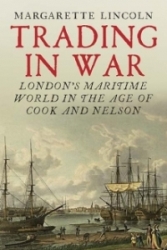 Pirates and Privateers Pirates and Privateers
The History of Maritime
Piracy
Cindy Vallar, Editor
& Reviewer
P.O. Box 425,
Keller, TX 76244-0425
    
Books for Adults ~ History: Piracy
British Pirates and Society
Trading in
War

British Pirates and Society,
1680-1730
by Margarette Lincoln
Ashgate, 2014, ISBN 978-1-4724-2993-3, UK £70.00 / US
$124.95
Also available in other formats
    
Dr.
Lincoln is Deputy Director of and Director of
Research and Collections at the National Maritime
Museum in London. In her latest study of the early
18th century, she examines how contemporaries of
pirates viewed them. The period resources from which
she draws this wealth of information encompass
literature, official papers, ballads, newspapers,
periodicals, and manuscripts. She does stress that
“this is not first and foremost an attempt to
distinguish fact from fiction, but rather an
investigation of how the phenomenon of piracy
illuminates aspects of contemporary culture.” (3)
The one omission from piracy of this period concerns
the Barbary corsairs, because their piracy differs
from western piracy and is often state-sanctioned on
religious grounds.
The
first chapter serves as the introduction, focusing
on the pirates’ lifestyles, which both appealed to
and appalled various segments of society. She
clearly delineates the parameters of the study, as
well as explaining the differences between
privateering and piracy and why some people choose
the latter rather than adhering to more legal
pursuits. An interesting point that she makes here
is that just like today, people don’t agree on the
legal definition of piracy, which makes it
difficult to define who is a pirate and who is
not. This chapter also includes how pirates are
seen and/or depicted in print and art during this
period, which eventually leads to the “myth of the
swashbuckling pirate.” (11)
“Punishing Miscreants:
Pirates and the Metropolis” examines the impact
trials of pirates have on society and how such
events are portrayed in chapbooks, broadsides,
ballads, newspapers, and court proceedings. This
is a particularly absorbing account of the
judicial system, especially the prisons and life
within them.
In the third chapter,
Lincoln looks at pirates and the law. One case
pertains to Captain Thomas Green and two of his
crew, who are hanged in Scotland for piracy,
robbery, and murder, even though they are innocent
of the charges.
Chapter 4, “A Growing
Evil,” discusses the changing attitudes of
merchants (and others involved in commerce) toward
piracy, as well as the dangers seamen face at sea.
The steps the British government and others,
especially the East India Company, take to protect
trade are also covered.
The following chapter
focuses on how people of the middle and upper
classes view pirates, because those who write and
read about pirates come from these sectors of
society. An interesting point that Lincoln makes
in this chapter concerns the difference in dress
between male pirates (not lower class) and females
(lower-class dress).
For pirates who prey on
shipping in the Indian Ocean and for Caribbean
pirates who need a second venue when things become
too hot for them in that region, Madagascar is a
favorite haunt. “A Nest of Vermin,” chapter six,
examines how people of the 1700s view and portray
this exotic island.
While most contemporary
narratives make short shrift or don’t even mention
pirates’ wives, children, parents, and friends,
these people do exist, and this is the focus of
the seventh chapter. Lincoln also looks at how
pirates are used to debate gender perspectives
about marriage and their portrayal in romance
literature of this period. While she is usually
careful in how she phrases information that may or
may not be historically accurate, this isn’t true
when she discusses Anne Bonny after her stay of
execution because of her pregnancy. Here, Lincoln
states, “Anne’s father secured her release, and
after eight more children by a respectable
husband, she died in South Carolina, aged 84.”
(188) This theory is one possible explanation of
what becomes of Anne, but it has never been proven
beyond a reasonable doubt.
In the final chapter,
“Stand and Deliver,” the author explores the
heritage of these pirates and how their
depredations differ from those of modern-day
piracy.
Black-&-white
illustrations and a center set of color plates
accompany the narrative. Footnotes are found in
all chapters, while an extensive bibliography and
detailed index are included at the end of the
book.
Rather than focusing on
a particular aspect of the society, Lincoln
describes perspectives from a variety of classes,
those who associate with the pirates in some
fashion and others that wish them eradicated. Her
choice of covering the most prolific period in
pirate history deftly demonstrates how popular
opinions and attitudes concerning these rogues
change with the passing of time. This compelling
and significant study also allows readers to view
contemporary perspectives from many arenas, rather
than simply focusing on the legal or commercial
aspects. Highly recommended.
Review Copyright ©2015 Cindy
Vallar


Trading In War: London’s
Maritime World in the Age of Cook and Nelson
by Margarette Lincoln
Yale, 2018, ISBN 978-0-300-22748-2, US $35.00 / UK
£27.00
    
review by Irwin Bryan
Trading
in War begins with a walking
tour through Deptford, Wapping,
Shadwell, and other
mid-18th-century London districts
situated along the Thames River.
The pubs and ale-houses people
frequent, the churches where they
worship, and the types of housing
where they live are described in
great detail. So, too, are the
crowds of ships on the river and
the various businesses concerned
with building, repairing, and
servicing those vessels.
Before the American colonies
revolted, the East India Company
utilized most of the warehouses
and vendors aligned with the
shipbuilding industry. Voyages of
exploration, beginning with the
first of Cook’s Pacific journeys
in 1768, were all fitted out at
Deptford Yard. Innovations and
experimentation were ongoing in
the effort to make ships last
longer and improve sailors’ diet
and health. At the same time, this
quest for more scientific methods
began to impact the shipwrights
and other workers in the yards.
These “reforms” meant more work
for less pay and benefits, which
were resisted by yard workers, but
supported by their communities and
radical politicians. Strikes and
protests became frequent
occurrences, especially during the
wars with America and France when
the shipwrights’ services were
needed the most.
Efforts to recruit men as soldiers
and sailors included capturing and
forcing men into the militia and
Royal Navy. These often led to
disturbances and even violent
confrontations throughout the
maritime districts. Sailors went
into hiding during a “heavy press”
and the river was clogged with
fully-loaded ships that lacked
crews to sail them.
Women and the poor were
overburdened by the departure of
these family breadwinners. Various
social programs to assist these
women were established and
arrangements could be made for a
sailor’s pay to be collected by a
wife or mother. Still, these steps
were often not enough since the
funds were only available in
London and pay was often late, so
they went to workhouses or turned
to crime to provide for their
means. Expecting “crime” to have
meant prostitution and pick
pocketing, I was surprised to read
of women involved in felonies. In
1776, “two women were caught
red-handed in Golden Lane,
Smithfield, stealing 300 lb of
lead from some houses belonging to
St. Bartholomew’s Hospital.”(106)
A woman named Mary Lacey dressed
as a boy and ran away from home. A
naval carpenter in Chatham took
her on as his assistant, and she
sailed with the fleet. After four
years, “she left the navy and
trained as a shipwright at
Portsmouth dockyard, still dressed
as a man.”(144)
Some women, despite laws to the
contrary, took over an existing
business on the deaths of their
husbands. Ship chandler Michael
Browne of Wapping died at his home
in 1777. His widow immediately
signaled her intention to run his
business. She ran ads indicating
she hoped for “the continuance and
favors of all the friends and
customers of her late husband.”
(207) Amazingly, in 1795,
Frances Barnard took over the
private shipyard her late husband
had established in Deptford. She
continued to be awarded contracts
by the Navy Board and several
merchants.
The history of shipping on the
Thames always included problems
with goods being smuggled ashore
to avoid tariffs and thefts from
cargoes still on ships, while
being transported ashore, or from
the warehouses where the goods
were stored. Congestion on the
river was another difficulty faced
by the shippers and mercantile
companies.
By the time of the war against the
French Revolutionaries, there was
a push to build enclosed “wet
docks” where ships could quickly
be unloaded directly onto the
docks instead of “lightered” into
boats first. The dock complex
would have many berths, freeing
places on the river where the
increasing number of vessels
calling on London could anchor.
Tariffs on goods were replaced by
fees charged to the dock companies
and recouped by berthing fees. Each complex required
large tracts of land that
completely disrupted the affected
communities. Local businesses were
impacted by the decline of the
population as housing and other
structures were torn down where
the docks would be built. Many
“lightermen” who transported goods
from ship to shore were no longer
needed and cheaper labor could be
used to unload ships at the docks.
The West India Dock was opened in
1802, and others would follow in a
constant upheaval of the maritime
districts.
In presenting the information in
this book, the author uses a
variety of contemporary sources
that are carefully indicated in
the notes after the text. A
wonderful, sixteen-page inset of
color paintings and maps
illustrate the text. Many
references and books for further
reading are listed in the
bibliography, which is followed by
an extensive index.
My only criticism pertains to the
title. “Trading in War,” by
itself, gives the impression that
the effects on trade during the
wars are covered. I had hoped to
read about depredations by
privateers, increases in insurance
rates, and the need for ships to
be convoyed for protection. If
these three words were eliminated
from the title, this omission
would not mislead the reader. At
the same time, the book jacket
clearly indicates what the subject
matter actually is and only those
of us who often skip this
information are led astray.
This is an excellent portrayal of
the districts along the Thames and
the many ways they formed the
backbone of London’s establishment
and growth as a world port. Many
topics are covered, but the use of
various individuals’ stories makes
it easy to understand and remember
them. Anyone interested in a
glimpse of waterfront life during
these war years, the development
of London and the Port of London,
and those wanting to know more
about shipbuilding or the Royal
Navy will all be happy they read
this wonderful book.
Review
Copyright ©2018 Irwin Bryan


Click to contact me
Background image compliments
of Anke's Graphics |


